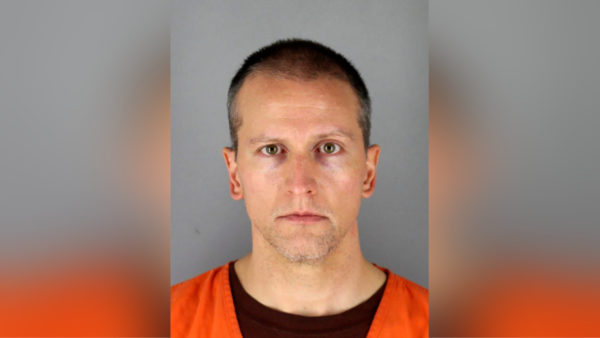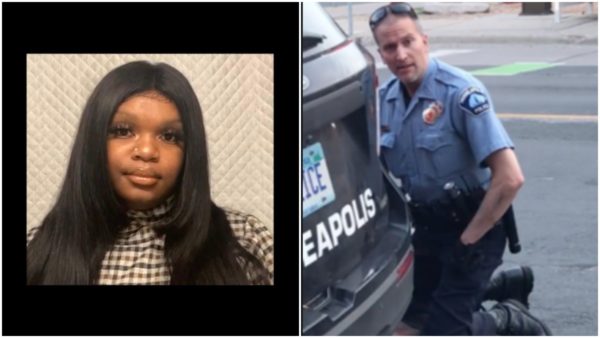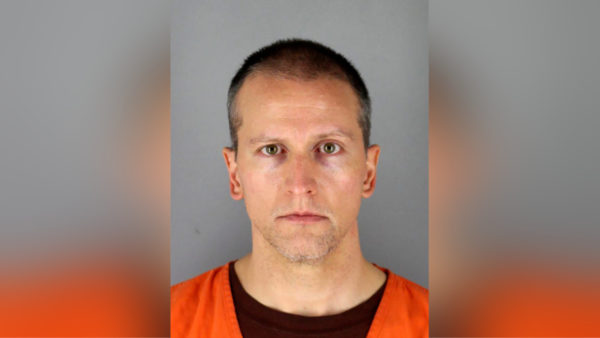‘I’ve Stayed Up Apologizing to George Floyd’: Teen Who Filmed Floyd’s Last Moments Expresses Immense Grief During Testimony In Derek Chauvin Trial
Minneapolis 911 dispatcher Jena Scurry knew something was not right as she watched the slow-moving death of George Perry Floyd Jr. live on video last May.
Minneapolis police officer Derek Chauvin pitted his knee in Floyd’s neck as two other officers helped restrain him on the pavement May 25. Scurry said the alleged brutality went on for such a long time she thought the police camera on which she was watching it unfold in real time had frozen.
“My instincts were telling me that something’s wrong,” Scurry testified, as reported by The New York Times.

Jurors watched footage from the police camera, which was affixed atop the canopy of a gas station across the street from Floyd’s fateful encounter. It was the first time the video has been released publicly and gave a firsthand look at what Scurry saw as the incident was happening.
She was so alarmed that she called the officers’ supervising sergeant. “You can call me a snitch if you want to,” Scurry began the conversation as she red-flagged the use of force she was witnessing Chauvin and fellow officers Thomas Lane, J. Alexander Kueng and Tou Thao use on Floyd.
Chauvin is charged with second-degree murder and manslaughter. The three other involved officers face charges of aiding and abetting second-degree murder and manslaughter. They are scheduled to be tried in August. All four men were fired shortly after the deadly confrontation.
Chauvin’s attorneys intend to convince jurors that Floyd died from a drug overdose and a pre-existing heart condition.
But prosecutor Jerry Blackwell is intent on proving that the former officer willfully killed Floyd. He told jurors Chauvin “didn’t let up, he didn’t get up” during his opening argument.
Scurry was the first witness to testify during Chauvin’s murder trial. She described the scene she saw by alluding to the extended length of time the officer’s knee was pressed against Floyd’s neck.
“It was long enough, long enough that I could look back multiple times,” she said, according to NBC News. “I first asked if the screens had frozen because it hadn’t changed.”

Cellphone video of Chauvin, a white officer, kneeling on Floyd’s neck as the Black man cried for help and lost consciousness sparked a global outcry last summer against police brutality and racial disparities in how law enforcement treats African-Americans. Original complaints from the Hennepin County Sheriff’s office indicated he kept it placed there for 8 minutes, 46 seconds, a point of focus that became a rallying cry during the monthslong wave of protests that erupted last summer.
In mid-June, prosecutors acknowledged a one-minute error in the length originally reported, saying 7:46 actually elapsed before Chauvin lifted his knee off Floyd’s throat.
But during opening arguments Monday, the prosecution presented a new theory that Floyd was pinned beneath the defendant’s knee for 9:29, partly based on time stamps from officers’ bodycam videos, The Associated Press reported. Blackwell played jurors a more than nine-minute video recorded by a bystander.
“You can believe your eyes, that it’s homicide — it’s murder,” he said. “Nine-two-nine. The three most important numbers in the case.”
Day two of testimony continued Tuesday at the Hennepin County Courthouse in downtown Minneapolis. Darnella Frazier took the stand and testified about recording the infamous cellphone video of Floyd’s death that ignited a worldwide uproar.
Chauvin pinned Floyd to the ground outside a Cup Foods after an employee at the neighborhood grocery store called 911 to claim Floyd had used a phony $20 bill in the store.
Frazier, then a 17-year-old high school student when she encountered the scene, lived in the neighborhood near the store. She was walking to the store as officers restrained Floyd and said she was the first bystander to begin filming.

While being cross-examined by Chauvin’s defense attorney Eric Nelson on Tuesday, she told jurors she’d walked to the corner store hundreds of times at all times of the day and never felt unsafe.
She later indicated the viral video has changed her life drastically and broke down in tears while explaining how seeing Floyd’s death has impacted her personally.
“When I look at George Floyd, I look at my dad, I look at my brothers, I look at my cousins and my uncles, because they are all Black,” Frazier said. “I have a Black father, I have Black brothers, I have Black friends, and I look at how that could have been one of them.”
The high school student then shifted into the grief she said she deals with for not actively intervening to keep officers from killing Floyd.
“It’s been nights I’ve stayed up apologizing and apologizing to George Floyd for not doing more and not physically interacting…not saving his life. But it’s not what I should have done, it’s what he should have done,” she said, beginning to condemn Chauvin’s actions before the judge cut her testimony abruptly.
Donald Williams, whose testimony began Monday afternoon, continued testifying Tuesday morning. The MMA fighter described Floyd wriggling his face from side to side under Chauvin’s knee as he gasped for air and his eyes rolled back in his head. Williams said he yelled at the officers at the scene and at one point stepped off the curb in an effort to help Floyd, but it was to no avail.
He said Chauvin even kept his knee on Floyd’s neck after paramedics arrived and were trying to check his pulse. Williams later called 911 to report the officers who were still on the scene after Floyd was transported by ambulance. Williams dabbed away tears as he listened to an audio recording of his 911 call, Yahoo reported.
“No feelings or no remorse and no response from the officer,” Williams testified, describing Chauvin. “I did call the police on the police, because I believe I witnessed a murder.”

